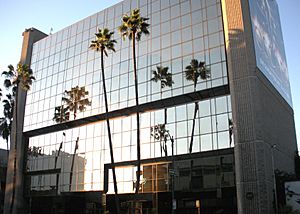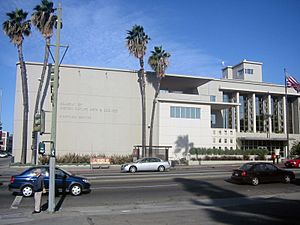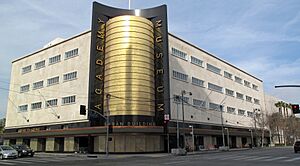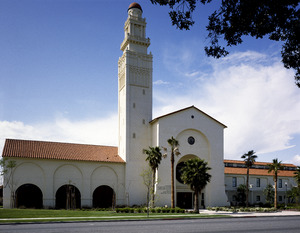Academy of Motion Picture Arts and Sciences facts for kids
 |
|

Headquarters building
|
|
| Abbreviation | AMPAS |
|---|---|
| Formation | May 11, 1927 |
| Type | Trade association |
| Legal status | 501(c)(6) |
| Purpose | To recognize and uphold excellence in the motion picture arts and sciences, inspire imagination, and connect the world through the medium of motion pictures. |
| Headquarters | 8949 Wilshire Boulevard Beverly Hills, California, U.S. |
|
Membership
|
10,500 (2023) |
| Janet Yang (since 2022) | |
| Subsidiaries | Academy Museum Foundation 501(c)(3), Academy Foundation 501(c)(3), Archival Foundation 501(c)(3), Vine Street Archive Foundation 501(c)(3) |
|
Revenue (2019)
|
$147,889,867 |
| Expenses (2019) | $103,813,370 |
|
Employees (2018)
|
255 |
|
Volunteers (2018)
|
632 |
The Academy of Motion Picture Arts and Sciences (AMPAS), often called "the Academy" or "the Motion Picture Academy," is a special group in Beverly Hills, California, U.S. Its main goal is to make movies better and to celebrate the people who create them. A group of leaders called the board of governors manages the Academy. They make sure the Academy follows its rules and goals.
As of April 2020, about 9,921 movie professionals were part of the Academy. It is an international group, and filmmakers from all over the world can join if they meet the requirements.
The Academy is famous worldwide for its yearly Academy Awards. These awards are also known as "The Oscars."
Besides the Oscars, the Academy also gives out other awards. These include the Governors Awards for people who have achieved a lot in movies over their lifetime. They also give Scientific and Technical Awards for new inventions in filmmaking. Young filmmakers in college can win Student Academy Awards. The Academy also helps writers with Nicholl Fellowships in Screenwriting.
The Academy runs the Margaret Herrick Library in Beverly Hills. This library has many books and materials about movies. They also have the Pickford Center for Motion Picture Study in Hollywood, Los Angeles. In 2021, the Academy opened the Academy Museum of Motion Pictures in Los Angeles.
Contents
History of the Academy
The idea for the Academy of Motion Picture Arts and Sciences (AMPAS) came from Louis B. Mayer. He was the head of Metro-Goldwyn-Mayer (MGM), a big movie studio. He wanted to create a group that could help solve problems in the film industry. He also wanted to make the movie industry look better to the public.
Mayer met with actor Conrad Nagel, director Fred Niblo, and producer Fred Beetson. They talked about creating a special club that would have a yearly dinner. At first, they did not talk about giving out awards. They decided that only people working in five main areas of the industry could join. These areas were actors, directors, writers, technicians, and producers.
On January 11, 1927, Mayer invited 36 film industry people to a dinner. It was held at the Ambassador Hotel in Los Angeles. That night, Mayer introduced his idea for the International Academy of Motion Picture Arts and Sciences. Everyone at the dinner became a founder of the Academy. Before the official papers were filed on May 4, 1927, the word "International" was removed. It became the "Academy of Motion Picture Arts and Sciences."
The first official meeting was on May 6, 1927. On May 11, at the Biltmore Hotel, Douglas Fairbanks, Sr. was chosen as the first president. Fred Niblo became the first vice-president. The Academy also gave its first honorary membership to Thomas Edison. At first, the Academy had five main groups: Producers, Actors, Directors, Writers, and Technicians. More groups have been added over the years.
At first, the Academy focused on work-related issues. But over time, it changed. It became more about honoring achievements in film. During the Great Depression, the Academy supported the big movie studios. This made many employees lose trust in the Academy regarding work issues. So, the Academy became what it is today: an organization that celebrates excellence.
One of the first groups formed in the Academy was for "Awards of Merit." In May 1928, this group started talking seriously about how the awards would work. By July 1928, the leaders approved a list of 12 awards. They also set up the voting system. This "award of merit for distinctive achievement" is now known as the Academy Awards.
The Academy's first office was on Hollywood Boulevard. In November 1927, it moved to the Roosevelt Hotel. That same month, the Academy's library started collecting books about the film industry. In May 1928, they decided to build a special movie screening room in the hotel. It was finished in April 1929.
In July 1928, the Academy started publishing books to help its members. One of the first was about lighting. During World War II, the Academy helped train soldiers. These soldiers later won two Oscars for their films.
In 1929, the Academy worked with the University of Southern California. Together, they created America's first film school. Famous people like Douglas Fairbanks and D. W. Griffith were among the first teachers.
In 1930, the Academy moved again to the Hollywood Professional Building. This was because it needed more space for its growing staff. By December 1930, its library was known as one of the best for movie information. They moved again in 1935. The offices went to the Taft Building, and the library moved to a different street.
In 1934, the Academy started publishing the Screen Achievement Records Bulletin. Today, this is called the Motion Picture Credits Database. It lists film credits for movies considered for an Academy Award. It also lists other films released in Los Angeles. This information comes from the Academy's Margaret Herrick Library. Another important publication was the Academy Players Directory in 1937. The Academy published this until 2006.
The Academy has been involved in the technical side of filmmaking since 1927. By 1938, its Science and Technology Council had 36 groups. These groups worked on things like sound, projection, lighting, and film preservation.
In 1946, the Academy needed a new main office. It bought the Marquis Theatre in West Hollywood. They renamed it the Academy Awards Theatre. This building was used for offices and events. It was a good choice because the 21st Academy Awards in 1949 were held there at the last minute.
In 1972, the Academy bought land in Beverly Hills. They built their current main building there. The new building opened in 1975.
In 2009, the first Governors Awards were held. At this event, the Academy gives out special awards. These include the Academy Honorary Award and the Jean Hersholt Humanitarian Award.
In 2016, the Academy faced criticism. People said it did not recognize the achievements of minority professionals enough. For two years in a row, all 20 nominees in the main acting categories were white. The Academy's president, Cheryl Boone Isaacs, first said there was no problem. But when the nominations were all white again, many people were upset. Gil Robertson IV, president of the African American Film Critics Association, called it "offensive."
Director Spike Lee said the problem was with Hollywood's leaders. He said, "We're not in the room." Boone Isaacs later said she was "heartbroken and frustrated about the lack of inclusion." She said it was "time for big changes." After her statement, many famous African-Americans called for a boycott of the 2016 Oscars. These included Spike Lee and actors Will Smith and Jada Pinkett Smith.
Because of this pressure, the Academy's board voted to make big changes. They wanted to double the number of women and minority members by 2020. While the Academy has worked to include more African-Americans, it is still working to raise the profile of other people of color artists.
In 2018, the Academy invited a record 928 new members. In August 2019, David Rubin was chosen as the Academy's president.
In 2020, Parasite became the first non-English language film to win Best Picture. In June 2022, Bill Kramer became the CEO of the Academy. Also in 2022, Janet Yang was elected as the first Asian American President of the Academy.
Academy Buildings and Theaters
The Academy has several buildings in the Los Angeles area. These include its main office in Beverly Hills. It also has two Centers for Motion Picture Study. One is in Beverly Hills, and the other is in Hollywood. These centers hold the Academy's Library, Film Archive, and other programs.
Current Locations
Academy Headquarters
The Academy Headquarters Building in Beverly Hills, California used to have two art galleries. These galleries showed different exhibits about films and movie stars. They were closed to make way for the Academy Museum of Motion Pictures. The museum opened in 2021.
The building has the Samuel Goldwyn Theater. This theater can seat 1,012 people. It was built to show movies with the best sound and picture quality. The theater is used all year for movie premieres and special events. This includes the live TV announcement of the Academy Awards nominations every January. The building also had a smaller theater, but it was changed into office space.
Pickford Center for Motion Picture Study

The Pickford Center for Motion Picture Study is in Hollywood. It is named after the famous actress and Academy co-founder Mary Pickford. This building holds several Academy departments. These include the Academy Film Archive and the Science and Technology Council. It also manages the Student Academy Awards and the Nicholl Fellowships in Screenwriting. The building was first opened in 1948. It is the oldest building in Hollywood made for television. It also has the Linwood Dunn Theater, which seats 286 people.
Fairbanks Center for Motion Picture Study
The Fairbanks Center for Motion Picture Study is in Beverly Hills. It is named after the famous actor and Academy co-founder Douglas Fairbanks. This center is home to the Academy's Margaret Herrick Library. This library is famous worldwide. It has a huge collection of materials about the history of movies. The library opened in 1928. It is open to the public and used by students, historians, and movie professionals. The library is named after Margaret Herrick. She was the Academy's first librarian. She also helped make the Oscar ceremony a big TV event.
The building itself was built in 1928. It was first a water treatment plant for Beverly Hills. Its "bell tower" held equipment to clean water.
The Academy Museum of Motion Pictures

The Academy Museum of Motion Pictures is the newest building linked to the Academy. It is the first large museum in the United States just for the film industry. It opened on September 30, 2021. The museum has over 290,000 square feet of space. This includes galleries, movie theaters, and learning areas. The museum is in Los Angeles, in the historic May Company Building. It is now called the Saban Building.
Former Locations
Academy Theater in New York
The Academy also had a theater in New York City. It was called the Academy Theater at Lighthouse International. This theater had 220 seats. It was updated in 2011 with new sound and video equipment. The theater was in the building of Lighthouse International, a group that helps people with vision loss. In July 2015, the Academy had to move out. This was because Lighthouse International sold the building.
Academy Membership
Academy membership is split into 19 different groups called branches. Each branch represents a different job in making movies. Members can only belong to one branch. If someone's work does not fit into a branch, they can be a "Member at Large." These members have most of the same rights as branch members. There are also "Associate members." These are people who work closely with the industry but do not make movies. They do not vote on Academy Awards. As of 2024, the Academy has 10,894 members. The largest group is the actors branch, with 1,258 members.
To become a member, you must be invited by the Board of Governors. Two current members from a branch can suggest someone to join. Also, anyone nominated for an Oscar is considered for membership. Each spring, the Board decides who to invite. New members are announced in a press release. Once you are accepted, your membership does not end.
In 2012, a study looked at over 5,000 Academy members. It found that most members were white, male, and over 50 years old. About a third of members had won or been nominated for an Oscar themselves. On June 29, 2016, the Academy started to change how it chose members. The new group of invited members included 46% women and 41% people of color.
This effort to make the Academy more diverse was helped by social activist April Reign. She created the Twitter hashtag #OscarsSoWhite. This hashtag criticized the lack of non-white nominees for the 2015 Academy Awards. The hashtag got a lot of attention. When the 2016 Oscar nominees were all white again, many people were upset. April Reign brought back #OscarsSoWhite. Her efforts led to a global discussion about fairness in film.
Because of this pressure, the Academy changed its rules. They wanted to make sure future members better represented movie audiences. The A2020 initiative was announced in January 2016. Its goal was to double the number of women and people of color in the Academy by 2020. As of 2020, 25 of the 54 members on the Board of Governors are women.
The Samuel Goldwyn Theater in Beverly Hills, California, shows many new films to Academy members. Since 2021, films being considered for awards are available to members through a special streaming app. This replaced sending out physical copies of movies.
Membership Changes
Five people are known to have been removed from the Academy. Academy officials say other members have been removed in the past. Most of these were for selling their Oscar tickets.
- February 3, 2004 – Actor Carmine Caridi was removed for sharing movie copies he received.
- October 13, 2017 – Producer Harvey Weinstein was removed for serious misconduct after an emergency meeting.
- May 1, 2018 – Actor Bill Cosby and director Roman Polanski were removed for violating the Academy's rules of conduct.
- March 17, 2021 – Cinematographer Adam Kimmel was removed in 2021 after a news story about him.
Some members have also chosen to leave the Academy.
- Sound engineer Tom Fleischman left the Academy on March 5, 2022. He was unhappy that some award categories were not shown live during the 94th Academy Awards ceremony. Production sound mixer Peter Kurland also left on March 23, 2022, for the same reason.
- Actor Will Smith announced he was leaving the Academy on April 1, 2022. This was five days after an onstage incident involving Chris Rock at the 94th Academy Awards.
Academy Branches
The Academy has different branches for people working in various parts of filmmaking:
- Actors
- Animation
- Casting Directors
- Cinematographers
- Costume Designers
- Directors
- Documentary
- Executives
- Film Editors
- Makeup Artists and Hairstylists
- Marketing and Public Relations
- Music
- Producers
- Production and Technology
- Production Design
- Short Films
- Sound
- Visual Effects
- Writers
Board of Governors
As of April 2020, the board of governors has 57 members. There are three governors from each of the 19 Academy branches. There are also three governors-at-large. The board of governors is in charge of how the Academy is run. They set the main rules and goals. They also choose a CEO and a COO to manage the Academy's daily activities.
Original 36 Founders
These are the people who were invited by Louis B. Mayer in 1927. They all became founders of the Academy:
|
|
|
Academy Presidents
Presidents are chosen for one-year terms. They can serve for a maximum of four terms in a row.
| # | Name | Term |
|---|---|---|
| 1 | Douglas Fairbanks | 1927–1929 |
| 2 | William C. DeMille | 1929–1931 |
| 3 | M. C. Levee | 1931–1932 |
| 4 | Conrad Nagel | 1932–1933 |
| 5 | J. Theodore Reed | 1933–1934 |
| 6 | Frank Lloyd | 1934–1935 |
| 7 | Frank Capra | 1935–1939 |
| 8 | Walter Wanger (1st time) | 1939–1941 |
| 9 | Bette Davis | 1941 (resigned after two months) |
| 10 | Walter Wanger (2nd time) | 1941–1945 |
| 11 | Jean Hersholt | 1945–1949 |
| 12 | Charles Brackett | 1949–1955 |
| 13 | George Seaton | 1955–1958 |
| 14 | George Stevens | 1958–1959 |
| 15 | B. B. Kahane | 1959–1960 (died) |
| 16 | Valentine Davies | 1960–1961 (died) |
| 17 | Wendell Corey | 1961–1963 |
| 18 | Arthur Freed | 1963–1967 |
| 19 | Gregory Peck | 1967–1970 |
| 20 | Daniel Taradash | 1970–1973 |
| 21 | Walter Mirisch | 1973–1977 |
| 22 | Howard W. Koch | 1977–1979 |
| 23 | Fay Kanin | 1979–1983 |
| 24 | Gene Allen | 1983–1985 |
| 25 | Robert Wise | 1985–1988 |
| 26 | Richard Kahn | 1988–1989 |
| 27 | Karl Malden | 1989–1992 |
| 28 | Robert Rehme (1st time) | 1992–1993 |
| 29 | Arthur Hiller | 1993–1997 |
| 30 | Robert Rehme (2nd time) | 1997–2001 |
| 31 | Frank Pierson | 2001–2005 |
| 32 | Sid Ganis | 2005–2009 |
| 33 | Tom Sherak | 2009–2012 |
| 34 | Hawk Koch | 2012–2013 |
| 35 | Cheryl Boone Isaacs | 2013–2017 |
| 36 | John Bailey | 2017–2019 |
| 37 | David Rubin | 2019–2022 |
| 38 | Janet Yang | 2022–2025 |
| 39 | Lynette Howell Taylor | 2025–present |
Source:
Current Academy Leaders
- Academy officers
- President – Lynette Howell Taylor
- Vice President / Secretary – Howard A. Rodman
- Vice President / Treasurer – Simon Kilmurry
- Vice President – Lesley Barber
- Vice President – Jennifer Fox
- Vice President – Lou Diamond Phillips
- Chief Executive Officer – Bill Kramer
- Governors
- Actors Branch – Marlee Matlin, Lou Diamond Phillips, Rita Wilson
- Animation Branch – Jinko Gotoh, Marlon West
- Casting Directors Branch – Richard Hicks, Kim Taylor-Coleman, Debra Zane
- Cinematographers Branch – Dion Beebe, Paul Cameron, Ellen Kuras
- Costume Designers Branch – Eduardo Castro, Isis Mussenden, Daniel Orlandi
- Directors Branch – Patricia Cardoso, Ava DuVernay, Jason Reitman
- Documentary Branch – Chris Hegedus, Simon Kilmurry, Jean Tsien
- Executives Branch – Pam Abdy, Peter Kujawski, Hannah Minghella
- Film Editors Branch – Nancy Richardson, Stephen E. Rivkin, Terilyn A. Shropshire
- Makeup Artists and Hairstylists Branch – Linda Flowers, Gerald Quist, Gigi Williams
- Marketing and Public Relations Branch – David Dinerstein, Laura C. Kim, Christina Kounelias
- Music Branch – Lesley Barber, Carter Burwell, Richard Gibbs
- Producers Branch – Jason Blum, Jennifer Fox, Lynette Howell Taylor
- Production and Technology Branch – Wendy Aylsworth
- Production Design Branch – K. K. Barrett, Kalina Ivanov, Missy Parker
- Short Films Branch – Chris Tashima
- Sound Branch – Peter J. Devlin, Andy Nelson, Mark Stoeckinger
- Visual Effects Branch – Rob Bredow, Brooke Breton, Andrew Roberts
- Writers Branch – Larry Karaszewski, Howard A. Rodman, Dana Stevens
- Governors-at-large (nominated by the President and elected by the board) – Haifaa al-Mansour, Effie T. Brown, Annie Chang
See also
 In Spanish: Academia de Artes y Ciencias Cinematográficas para niños
In Spanish: Academia de Artes y Ciencias Cinematográficas para niños


